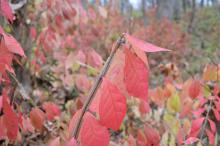
When we look at the current lists of plants that are deemed legally invasive by state and federal governments, we see species that were quite popular in the landscape in generations past. As we battle the current invasive species in our natural areas, there is a new generation of non-native shrubs that are currently quite popular in the home landscape which we are now seeing escape cultivation into the wild. Here are three shrubs that are recommended to avoid or remove.
Privet:
I haven’t grown much privet as most Ligustrum species are hardy to zone 6. Which places the northern edge of most privet species south of my zone 5 garden. However, a few species such as Korean privet (Ligustrum ovalifolium) and common privet (Ligustrum vulgare) are listed as being hardy up to zone 4. Privet certainly poses a problem in Southern Illinois, and there are also scattered reports of privet invading natural areas in Central Illinois.
Traditionally, privet has been used as an evergreen to semi-evergreen hedge. Homeowners that have this plant in their landscape often laud its stellar performance. Conversely, landowners who work to eradicate escaped privet in natural areas curse this plant.
Burning Bush:
Based on my experience, it seems like everyone has burning bush (Euonymus alatus) planted somewhere in their yard. It is often
used as a hedge or foundation planting and it offers bright red fall color. Burning bush seedlings can commonly be seen popping up in landscape beds and anywhere else nature may take them. As I was weeding near the downspout of my house this spring, I noticed all the little seedlings were burning bush. If this shrub is this prolific in my yard, imagine those that escape into natural areas.
Japanese barberry:
This is another very common landscape shrub. You may know Japanese barberry (Berberis thunbergii) by its purple-leaved cultivar
forms such as “Crimson Pygmy” and the thorny nature of the stems. As I was walking along a wooded edge near my home, a green-leaved shrub stood out. Turns out it was Japanese barberry, only it had reverted to its normal green leaves. The only reason I figured it out was another escaped purple-leaved barberry seedling a few feet away.
Japanese barberry comes in many different shapes, sizes, and colors. Often these are used in landscape beds in mass or as an accent plant or as a screening plant.
Control:
If these common landscape plants have escaped into your natural areas, control options usually require an herbicide because these plants are tough, good at reproducing, and have no natural controls. (This is what makes them so desirable to the landscape industry.)
Herbicide – Cut stump method uses a concentrated glyphosate (20 to 50 percent) or triclopyr (20 to 25 percent) solution sprayed immediately on the remaining stump following cutting the plant. The foliar spray method uses a diluted solution of glyphosate (2 percent) or triclopyr (1 to 2 percent) sprayed on the plant’s foliage. Make sure to follow all label directions when using pesticides.
Additional control options can be found in the Invasive Plants and Pests of Illinois. https://extension.illinois.edu/sites/default/files/management_of_invasive_plants_and_pests_of_illinois.pdf
Native alternatives
Even though the above-mentioned plants are still completely legal to sell and grow in Illinois (as of spring 2021), I would encourage homeowners that have these plants in their yard to consider removal and replacement with a species that won’t damage natural areas. Here are some alternatives:
Inkberry holly (Ilex glabra) – A delightful evergreen shrub that can be used as a hedge, in landscape beds, or screening. Most inkberry hollies are bred for a compact habit as the lower stems can lose leaves and look leggy. These plants are fire-adapted and will regrow if cut to the base.
Red chokeberry (Aronia arbutifolia) – A red fall color to rival burning bush, red chokeberry offers more than bright autumn leaves. A profusion of white spring flowers followed by the development of red berries that persist into the winter. When compared to burning bush it’s a wonder why we even started planting that non-native shrub in the first place as it offers only single-season interest.
Winterberry holly (Ilex verticillata) - Winterberry is a deciduous holly hardy to zone 3. Red berries begin their display in September and can last for several months. Cultivars vary in height from 5 to 10 feet. This species is a good selection for shrub borders or screening.
Gray Dogwood (Cornus racemose) – A shrub that offers spring blooms and white fruit. It also has a noteworthy fall color of deep red to purple. Adaptable to full sun or part shade this shrub also does well in soil with normal to higher moisture conditions.
Virginia Sweetspire (Itea virginica) – A shrub native to the southernmost counties of Illinois, you can find it planted and sold throughout the state. The most common cultivar is ‘Henry’s Garnet’. Known for bottlebrush-shaped, white spring flowers, and outstanding fall color, this shrub stands up well to wet soils.
Dwarf Fothergilla (Fothergilla gardenii) – A personal favorite. Dwarf fothergilla has some noteworthy cultivars that emphasize fall color, spring bloom, and leaf color. ‘Blue Shadow’ leaves stand out with a bluish hue. Meanwhile ‘Mt. Airy’ has outstanding red to maroon fall color, with other cultivars sporting orange or yellow fall color.
Other alternatives to consider – Oakleaf hydrangea (Hydrangea quercifolia), Highbush blueberry (Vaccinium corymbosum), Summersweet (Clethra alnifolia), Mapleleaf viburnum (Viburnum acerifolium), Possumhaw viburnum (Viburnum nudum), Arkansas bluestar (Amsonia hubrichtii)
Learn more about Illinois invasive species.

